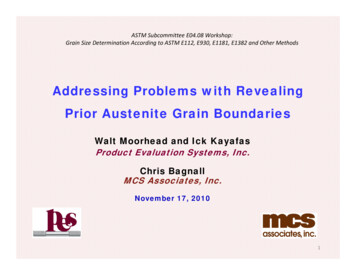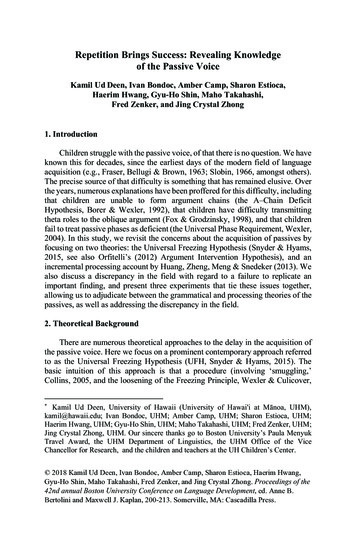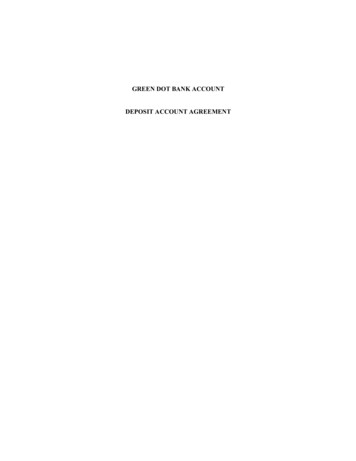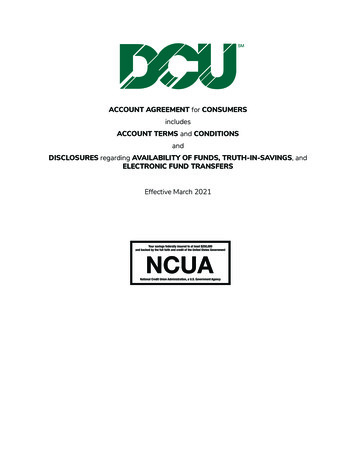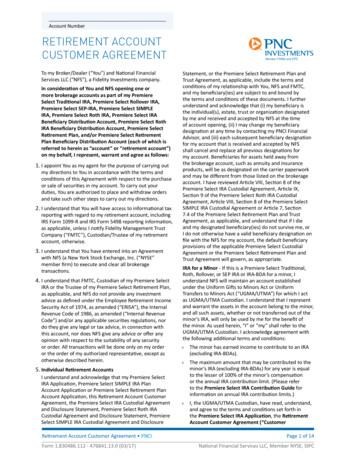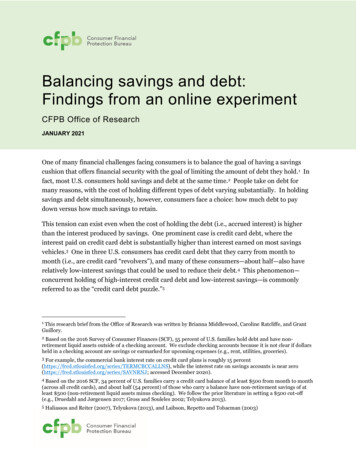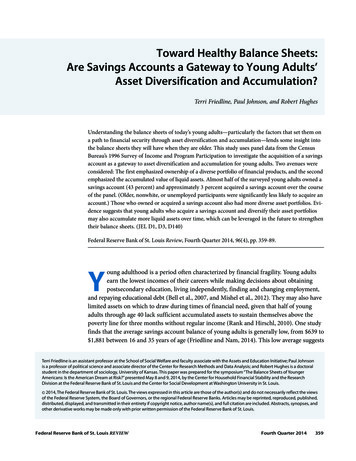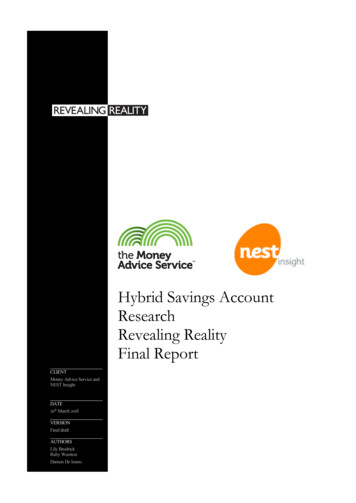
Transcription
Hybrid Savings AccountResearchRevealing RealityFinal ReportCLIENTMoney Advice Service andNEST InsightDATE20th March 2018VERSIONFinal draftAUTHORSLily BrodrickRuby WoottonDamon De IonnoCLIENTConsumer First PanelRevealing Reality (ESRO)research proposal
Executive SummaryBACKGROUNDAuto-enrolment has created a new generation of savers across the UK. Millions of people arenow building their retirement savings, often for the first time. However, many still have little orno money on hand to protect themselves from the effects of unexpected, short-term financialshocks.1 This is a concern. Especially as nearly three-quarters of households receive anunexpected bill every year and 44% of working-age adults have less than 100 in a formalsavings account.2 In partnership with NEST, the Money Advice Service (MAS) wanted toexplore whether the success of the auto-enrolment model in pensions could be applied to helpaddress the lack of short-term, emergency savings.One possible solution is a new concept, a hybrid savings product, called a pensions sidecaraccount. This is a liquid, capped savings account which sits alongside a workplace pension,topped up by additional contributions.The high-level principles for a large-scale field trial of the pensions sidecar account have beenproposed. But MAS and NEST wanted to test specific features. Specifically, they needed toexamine the most appropriate threshold and contribution levels, how best to frame the sidecarproposition, and how best to deliver it.To meet these objectives, this research developed over two phases:PhaseActionsSet up and scoping A literature review/knowledge audit Four interviews with experts from thefinancial services, marketing andcommunication industriesInvestigating and testing Ten focus-groups around the UK with 4–6employees of large organisations. All earning 10,000–35,000 per year (gross), in MAS’sStruggling or Squeezed segments, and withsavings below 500 A single-day workplace visit to observe theemployer context, as well as run organisedfocus groups and ad hoc in-depth interviewswith employeesThe findings of this research will inform a large-scale field trial of the concept in 2018. This willinvolve selected employers offering the pensions sidecar account to their employees.1NEST Insight (2017) ‘Liquidity and sidecar savings’. Available at: http://www.nestinsight.org.uk/wp-2Money Advice Service (2016) ‘Closing the Savings Gap’ and event slides. Available sidecar-savings.pdfPage 2 of 20
KEY FINDINGSREACTIONS TO THE CONCEPT The pensions sidecar account was largely met with a positive response. Almost all felthaving savings “is a good thing”. The account’s main selling point is “peace of mind”. Having some savings makes peoplefeel more financially secure. A key benefit of the sidecar account is having contributions deducted through payroll. It’seasy and imposes some discipline. It means people don’t have to think about saving andthis might be a powerful tool to overcome inertia. Younger people are more optimistic about their ability to save in the future and so viewedthe proposition more favourably. Older people, and those with variable-hours employment,are less optimistic.FRAMING The name of the proposition is an important signifier of its purpose.o Calling it an “emergency fund” or “buffer” aligns it with unexpected costs.However, this is also makes people think of negative things happeningand, as such, isn’t a galvanising force for saving money.o Calling it a “rainy day fund” or “savings fund” suggests medium-term orlong-term savings. How the proposition is positioned also affects how it is perceived.o Talking about the level of contributions (e.g. 25 per month) is moreappealing than focusing on goals (e.g. saving 1,000). When setting goals,people tend to aim high and are then disappointed when they realise howlong the goal will take to reach.o Framing the product as a ‘tool’ rather than a savings ‘product’ or ‘scheme’means it’s viewed more favourably. It then isn’t compared to otherfinancial products and the various incentives they offer.o Promoting it as an alternative to high-cost credit is appealing.Page 3 of 20
DELIVERY Most want the option to control and change their threshold and contribution levels. Whilethe ideal amounts vary greatly, most expect to contribute 20–60 per month up to athreshold of between 1,000 and 5,000. While integral to the current proposition design, some people are suspicious of theircontributions overflowing into their pension. For them, this merges two very differentsaving objectives – short-term, emergency savings and long-term, pension savings. Thisview is compounded by the fact many feel they are already contributing ‘enough’ to theirpension. (However, throughout the research, we focused on the features, benefits andobjectives of the sidecar concept – not those of their workplace pensions.) In addition to the pensions sidecar account, many respondents suggested an additional‘middle-pot’ would be beneficial. This could sit between the emergency fund and long-termretirement savings. It would be for goal-based savings and would in some way have morerestricted access.Page 4 of 20
1. Background andMethodologyBACKGROUNDAccording to a report by StepChange Debt Charity, approximately 13 million people lack thesavings to afford one month’s worth of bills should their monthly income drop by a quarter.3There is increasing concern that this is exacerbating a cyclical problem of over-indebtedness,fuelling the demand for short-term, high-cost credit, and in turn making people’s financialsituations more precarious.Supporting the development of short-term savings has been identified as a way of overcomingthis. According to one report, for those households earning an average net annual income of 25,000 – and taking other significant factors into account – the odds of that householdexperiencing problem debt is reduced by approximately 44% if they were to have cash savingsof 1,000.4 Currently, many households tend to use a combination of savings and credit, andresearch reveals that these tend to be substitute goods: the lower an individual’s access tosavings, the more likely they are to use credit, and vice versa.5In response, multiple initiatives have been implemented to overcome these challenges, mostnotably, the auto-enrolment pension scheme, the government-funded development ofIndividual Savings Accounts (ISAs), and the proposed new ‘Help to Save’ scheme.Despite these initiatives, many people still don’t have the finances available to protectthemselves against unexpected bills. Research from the Money Advice Service shows that 44%of working-age adults have less than 100 in a formal savings account.6 This often leads to debtproblems, exacerbated by the fact that many people either do not use, or cannot access,affordable credit to cover them. Thus, there remains scope for an initiative or financial productthat works to encourage short-term savings behaviours.THE PENSIONS SIDECAR ACCOUNTIn recent years, practitioners, researchers and policy-makers have started to develop the idea ofa dual-purpose account. In 2014, the idea of a two-tiered system was floated – one which aimedto balance users’ liquidity needs with their long-term financial needs – otherwise known as a‘sidecar’ account.7, 8 The term ‘sidecar’ refers to a short-term savings account, which – when3 de Santos (2014) ‘Life on the Edge’, StepChange Debt Charity. Available LifeontheEdgereport.pdf4 StepChange Debt Charity (2014) ‘Savings and Problem Debt'. Available media/reports/Savings Report Select FINAL.PDFMcKay (2017) ‘Two birds, one stone: using hybrid financial products to manage income volatility’, Aspen Institute: Expanding Prosperity ImpactCollaborative. Available at: ge-incomevolatility/6 Money Advice Service (2016) ‘Closing the savings gap – event slides’. Available at: h7 Mitchell and Lynne (2017) ‘Driving Retirement Innovation: Can Sidecar Accounts Meet Consumers’ Short- and Long-Term Financial Needs?’Aspen Institute. Available at: 2017/06/FSP-Sidecar-Accounts-Brief.pdf8 Beshears et al. (2014) ‘Optimal Illiquidity’. Available at: https://eml.berkeley.edu/ webfac/seminars/Optimal Illiquidity 2014.pdf5Page 5 of 20
established as part of a hybrid product – would usually be paired with a longer-term savingsaccount.The pensions sidecar account seeks to build on the success of auto-enrolment, andcombine this with the need to solve the short-term savings challenge.9 The process ascurrently envisaged would require employees to opt in to increase their monthlycontributions. This overall deduction would then be split into the appropriate ‘pots’ –with the original contribution continuing to flow into the pension pot, and theadditional contribution flowing into the sidecar account. At the point when the savingscap on the account is reached, the additional savings contribution would begin to flowinto the pension pot alongside the original contribution. If the employee withdrawsmoney from the sidecar account at any point, contributions will revert back to the shortterm savings pot until it once again reaches the cap.“The overall concept is excellent . atan employee level, there’s about 17million employees in the UK withless than 100 of savings”Mark Rowlands, NESTExpert InterviewThe development of this pension sidecar savings account is in line with a number ofother similar hybrid products. Hybrid products work to boost vulnerable households’ financialsecurity,10 as well as enhancing the overall financial wellbeing of individual savers,11 throughoffering the user/customer several services in one. The Aspen Institute’s ‘Expanding ProsperityImpact Collaborative Initiative’ (2017) has identified hybrid financial products as a step in theright direction to supporting families who experience financial difficulty.12Moreover, hybrid products have gained increasing attention from governments, privateorganisations and not-for-profits. Until recently, initiatives designed to encourage short-termsavings on the one hand, and long-term savings on the other, have often been offered inisolation, implying a tension between liquid and illiquid savings.13THE OBJECTIVES OF THIS RESEARCHIn this research, the NEST Insight Team and MAS are collaborating to explore the idea of thepensions sidecar savings in more practical terms. This research builds on existing knowledge bytesting a hybrid concept with potential users and exploring various design features and deliverymechanisms. Our specific research objectives are to: understand existing behaviours in relation to savings, shocks and forward planning, andwhich structural incentives (i.e. tax relief, employer matching, prizes etc.) might contributeto positive behaviour change explore the potential merits of different service features of the sidecar savings account, tomaximise user retention and ensure a high-quality user experience identify the types of messaging/framing that will ‘cut through’ to employees to driveengagement with the pensions sidecar account present robust recommendations and principles regarding account features and roll-out /communications to inform the large-scale field trial in 2018.The findings of the research will inform a large-scale field-trial in 2018. This will involve selectedemployers offering the sidecar account to their employees.9NEST Insight (2017) Liquidity and sidecar savings. Available at: 017/09/Liquidity-and-sidecar-savings.pdfMcKay (2017) op cit.McKay (2017) ‘Two birds, one stone: using hybrid financial products to manage income volatility’, Aspen Institute: Expanding ProsperityImpact Collaborative. Available at: geincome-volatility/12 McKay (2017) op cit.13 McKay (2017) ‘Two birds, one stone: using hybrid financial products to manage income volatility’, Aspen Institute: Expanding ProsperityImpact Collaborative. Available at: geincome-volatility/1011Page 6 of 20
METHODOLOGICAL DETAILThe research methodology for this project can be broken down into two key phases: Phase 1 – set up and landscape scopingo A knowledge audit – consisting of rapid desk research and an internalknowledge review around current thinking, existing schemes/initiatives,existing behavioural insight, communications and messagingo 4 x Expert interviews (from financial services & marketing andcommunications industries) – understanding recent developments andcurrent thinking, as well as discussing potential marketing andcommunication strategies Phase 2 – investigating and testingo 10 x focus-groups with employees of large organisations (250 employees) – taking place during August 2017 in 5 locations across theUK (London, Manchester, Cardiff, Glasgow and Belfast), to test thepension sidecar concept and its key features, as well as the framing,communication and delivery channels that could potentially be used. Oneof the focus-groups was made up of employees who worked variablehours. Given the technical subject matter, we conducted smaller-thanusual groups – giving us greater scope to engage all individuals inthe focus group and enabling us to probe individual responsesand explain more clearly the sidecar account concept we weretesting, whilst still retaining some diversity in each of the sessions Respondents were asked to complete two ‘pre-activities.’ Thesewere both selfie-videos. One talked about their experiences ofborrowing money and regretting it, and the second asked themto share with us some savings that they have/once had andare/were proud of. To ensure we remained balanced, we built our sample aroundtwo dominant criteria: whether people considered themselves tobe ‘savers’ (those with 250- 500 approx. in savings) or ‘microsavers’ (those with less than 250 in savings) and their agegroup. All had a personal pre-tax income of 10,000 to 35,000(ensuring a range, but weighted towards those earning between 18,000 and 25,000). All respondents, bar three, were members of NEST or anotherdefined contribution (DC) pension scheme. NB: The three peoplethat didn’t have a DC pension scheme, had decided to opt-out of the autoenrolment process. All groups were sampled to meet the criteria of financially‘squeezed’ or ‘struggling’.14 Overlaying the core sample framework, we covered thefollowing criteria: 50:50 gender split; spread of ethnicities; arange of employment sectors and geographical spread. All respondents were recruited via a mixed-method approach.15Money Advice Service (2016) ‘Market Segmentation: An Overview’. Available 00/568/original/Market Segmentation report An overview.PDF15 A mixed-method approach to recruitment refers to the combination of various recruitment methods, such as utilising social media as well asmore traditional methods, such as on-street and telephone recruitment. It also tends to involve recruiting through a wide business and publicdatabase.14Page 7 of 20
2. Key ResearchFindingsFinancial behaviours and needsSECTION SUMMARYAlmost all respondents that took part in this research recognised that savings were a positivething, and that they contributed to greater financial security. The vast majority of respondentsreported that they struggled to save, and were largely positive about the prospect of tools orsupport that would help them to do so. There was widescale recognition of the differentobjectives to savings, and how additional support to save would help them reach their differentfinancial goals, i.e. saving for emergencies, a short-term goal (holiday/car), and a long-term goal(mortgage/retirement).MOTIVATIONS TO SAVEAlmost all respondents across the groups recognised that savings were a positive thing thatcould ensure people are more financially secure and resilient to income shocks. Moreover, manyreported that a lack of savings was a significant cause of stress and anxiety for them, and theprospect of greater “peace of mind” as a result of more savings was a significant motivator.“I can’t seem to save above a certain amount. I’m always backpedalling”(30–49, Manchester, saver)“Every month I put a certain amount away, but there are costs which come out of nowhere which have to be paidfor. I usually go into my savings for that”(Under-30s, Belfast, micro-saver)Respondents’ motivation and aspiration to save varied across the sample – most notably by agegroup and life-stage. Respondents within the over-50s segment of the sample were much morepessimistic about their potential to accumulate savings, with many expressing the view that itwas too late for them to save enough for it to have a worthwhile impact. Respondents withyoung families also tended to feel less optimistic about their ability to increase their savings.Those respondents who had more variable hours employment (and therefore variable incomelevels) were also among those who were less optimistic about their future finances and abilityPage 8 of 20
to save – often reporting that any savings they did manage to set aside during a “good month”was only ever enough to cover themselves during a “bad month”.Younger respondents on the whole were more optimistic about their future likelihood ofsuccessful saving. Individuals within the under-30s groups tended to be more positive abouttheir future financial situations more generally – anticipating higher future salaries and ability tomake significant financial commitments such as home buying, holidays, cars etc.Despite the positive attitudes towards saving and the appeal of being in a more secure financialposition many felt that their income level didn’t allow them to put more than a small amountregularly into savings. They often found themselves withdrawing / using money previously setaside as savings to cover the cost of essentials towards the end of the month.For some, this seemed to lead to a tendency to discount the prospect of saving at all – andseveral reported the demotivating effect of seeing savings accumulate extremely slowly. Thiswas compounded by many people admitting that they didn’t like to think that negative orchallenging events would happen to them – and therefore the appeal of saving specifically for‘emergencies’ was less motivating than saving for something enjoyable.BORROWING AND ACCESSING CREDITAcross the sample, most respondents had borrowed money to cover unexpected expenseswithin the last few months – turning to family and friends or credit options (e.g. credit card,credit union, finance deals, overdraft).While the prospect of having available savings to use as an alternative to borrowing wasappealing to most – many felt that it wouldn’t necessarily prevent them from using credit orborrowing money. For example, when presented with a scenario such as an unexpected bill ora broken appliance, several respondents reported that they would prefer to borrow money fromfamily or use a 0% interest credit card to pay for this, rather than use their own savings. Theyfelt they would be more likely to feel pressure to repay money to others (e.g. family or creditors)than “repay themselves”. This was especially the case when discussing savings they hadaccumulated with a specific goal in mind – e.g. a holiday or significant purchase.“I feel like I’d rather borrow it because then I know I have to pay it back, whereas you don’t have to pay yourpot fund thing back you don
account. This is a liquid, capped savings account which sits alongside a workplace pension, topped up by ad

